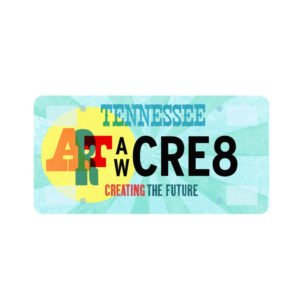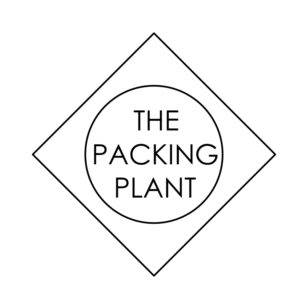INTERVIEW: KATIE ARONAT
JUN. 02, 2025
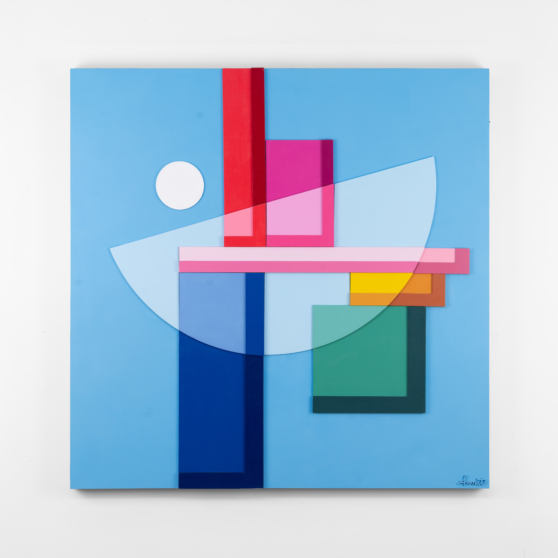
INTERVIEW: KATIE ARONAT
JUN. 02, 2025
Rachel Bubis: You describe your work as existing at “the intersection of digital design and hands-on craftsmanship, where digital sketches and designs transform into vibrant, abstract compositions with a pronounced sense of depth and dimension.” You explain how you start in the digital world and then go to physical - do you ever do the opposite order? What do you think you gain and/or lose during this translating process?
Katie Aronat: While most of my work begins digitally, there have been moments when the accidental arrangement of cut-out shape scraps catches my eye. In those rare cases, I’ll snap a photo or use the physical composition as a jumping-off point for a digital sketch.
Still, my process is primarily rooted in moving from digital to physical.
Digitally, I have infinite freedom to experiment with shape, color, and composition without worrying about wasting materials. It’s a space for exploration, iteration, and play.
But once I transition into the physical (cutting, painting, gluing), it shifts into pure execution. There’s very little room for experimentation at that stage since the design is already decided. Sometimes I miss that freedom mid-process. I’ll feel the urge to swirl my brush around or create something spontaneous, which is why I keep a few canvases nearby as a “play area” for leftover paint. It’s my way of keeping some of that abstract, intuitive energy alive.
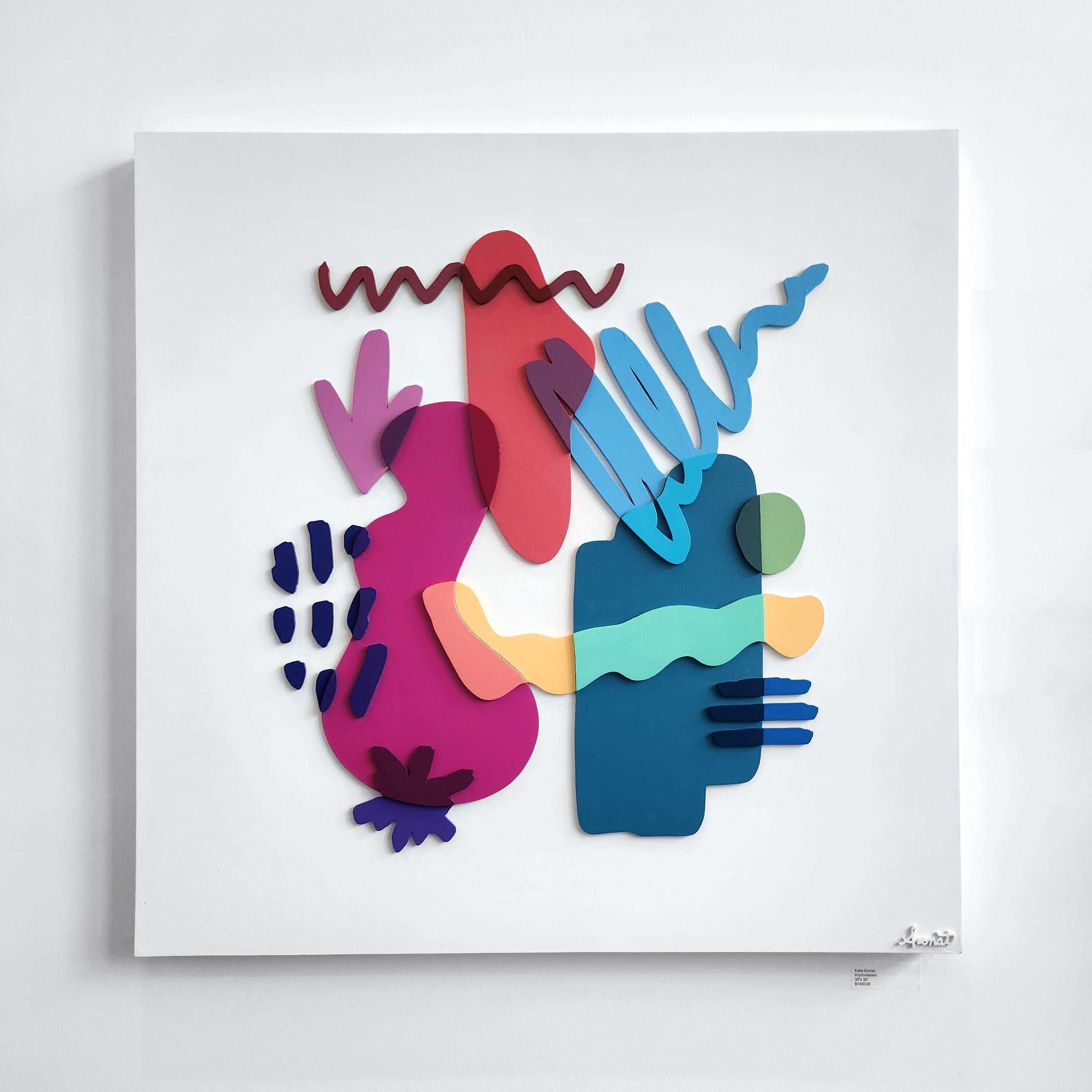
Improvisation, acrylic-painted, laser-cut wooden shapes on panel, 30" x 30"
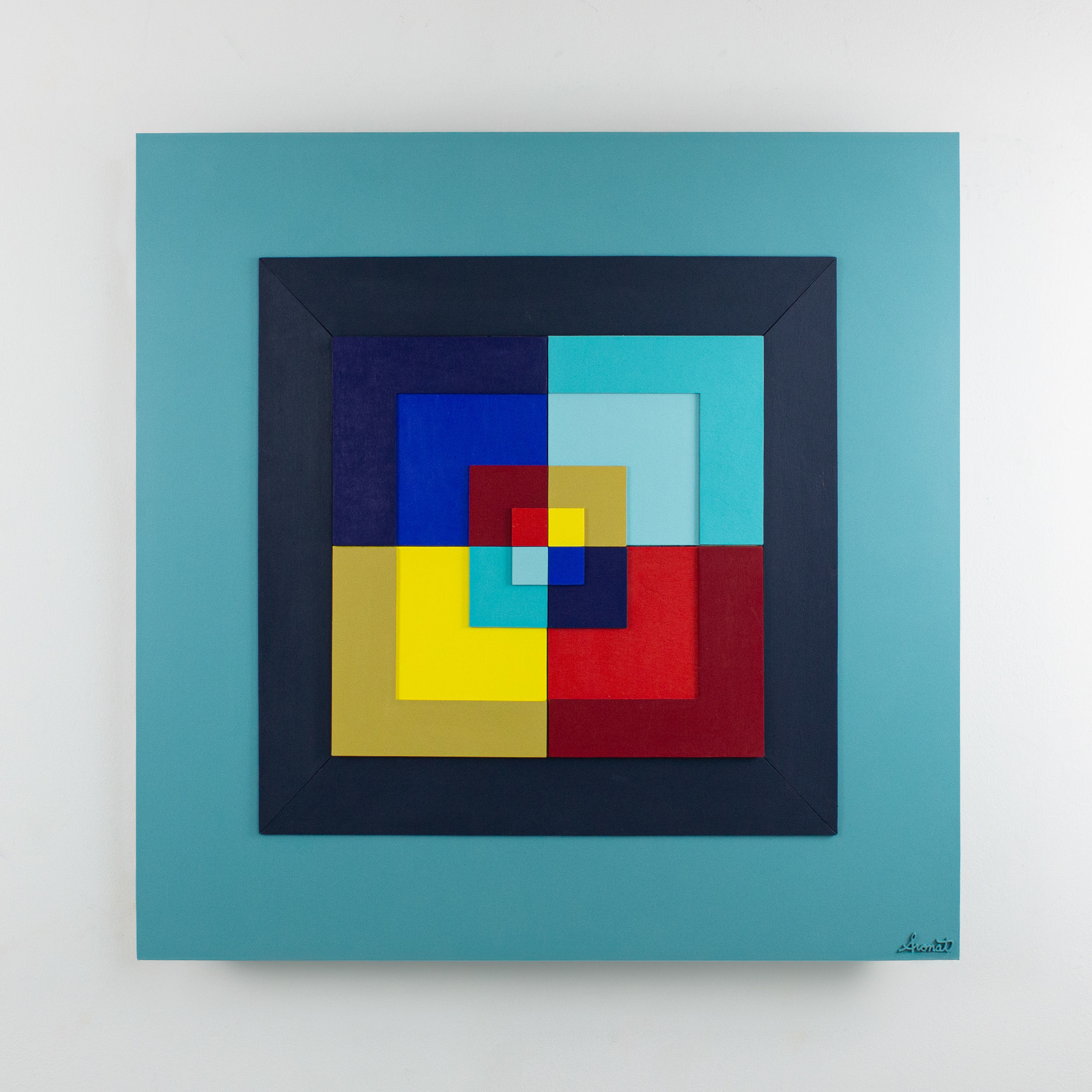
Echoes #1, acrylic-painted, laser-cut wooden shapes on panel, 30" x 30"
RB: What software do you use? What physical tools do you use? Can you walk me through this process? I know you cut shapes with a machine and paint them with acrylic paint...
KA: My more organic designs usually start as digital sketches in Procreate on my iPad, where I can draw freely and intuitively. For more geometric compositions, I tend to go straight into Adobe Illustrator. Once in Illustrator, I refine the shapes, adjust the composition, and play with color until the design feels complete.
Preparing the individual elements for cutting is almost like designing a puzzle. It requires strategic layering to ensure the overlapping of the shapes works properly. Once the design is finalized, I export the components and cut them using either my Cricut machine (for paper) or my X-Tool D1 Pro laser cutter (for wood).
After cutting, each piece is labeled, primed, and sanded. Then I hand-paint every element using Golden acrylic paints and assemble the parts into layered compositions.
I create both paper and wooden versions of each design, using the same paint colors for both materials. These "sister" artworks share the same design but explore different textures and materials. It's important to note that my paper artworks are not prints, they are hand-cut and assembled, retaining layers and dimension.
RB: Do you ever consider your digital sketches as works in their own right?
KA: If you'd asked me last year, I probably would have said no, because for me, the work has always been about layering and dimension. But recently, I started creating prints of some digital designs. It’s been a useful way to show where the physical pieces originate from, and it helps clarify that my paper works are not reproductions, they're hand-cut originals.
Offering prints also gives people a more accessible entry point to my work. It allows someone to connect with a design they love, even if they’re not ready to invest in an original piece just yet. So while the digital sketch is usually a starting point, I’m beginning to appreciate it as a meaningful artifact in its own right.

Entanglement Rhapsody, acrylic-painted, laser-cut wooden & paper shapes on panel, 35" x 45"
RB: How is your experience different working digitally vs. physically? Is one more relaxing? Energetic? Does one process come easier than the other?
KA: I love my digital playground of shapes, squiggles, and colors. It’s fast, experimental, and low-stakes. I can iterate endlessly, try out multiple color palettes, and always return to previous versions. That flexibility makes it exciting, but it can also feel overwhelming. There’s so much potential in a blank canvas that getting started can be intimidating. Where do I even begin? But once inspiration strikes and I get into a flow, it’s a rush!
The physical side of my process is completely different in pace and energy. I love the moment when my designs start becoming real, when the abstract shapes I created on a screen begin to exist as tangible objects. Using cutting machines gives me a level of precision I could never achieve by hand, and I find comfort in that structure.
At this stage, the work becomes more meditative. There’s a rhythm to labeling, priming, sanding, and painting that pulls me out of my head and into my body. Then comes my favorite part: assembling the dried pieces into the final composition. Seeing the layers come together, watching the piece come to life, always gives me butterflies. It’s the moment the work fully transitions from idea to object, and that transformation never gets old.
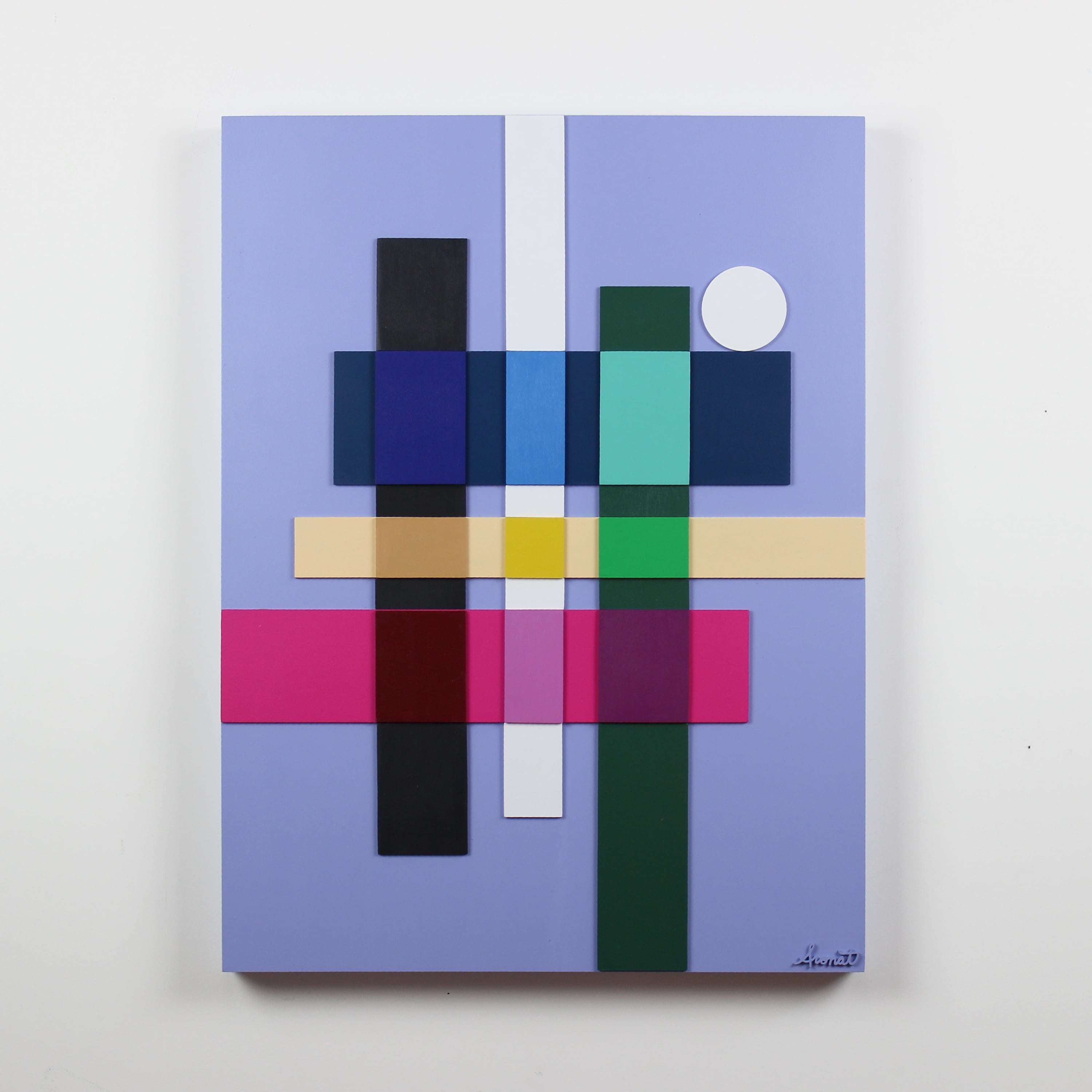
Orientations #2, acrylic-painted, laser-cut wooden shapes on panel,18" x 24"
RB: Do you have any thoughts you’d like to share about the impact of AI on digital design/art now and in the future?
KA: I think AI can be a useful tool, depending on how it's used. My art practice already involves a lot of technology, and I appreciate the shortcuts AI can offer for things like marketing or organizing my ideas. But when it comes to creating artwork, I believe it should come from people.
When something is generated by AI, even if it is visually impressive, it can feel hollow. Without the story of who the artist is, how it was made, the skill behind it, and the growth that happens along the way, the magic just isn’t there.
There will probably always be an audience for fast, inexpensive art that’s generated without a human touch. But I believe people will continue to seek out and value art that feels personal, intentional, and human.
RB: Do you have a favorite color?
KA: Based on the things I buy, I’m drawn most to greens, teals, and blues. But in my art, I can’t help but love them all!
RB: What are you working on now and what’s next?
KA: I recently wrapped up a few collections that leaned more geometric, so I’ve been finding my way back to squiggles and organic shapes. I have a giant digital artboard filled with half-finished sketches. Most of them don’t feel quite ready, but every so often, one grabs my attention and I get the urge to bring it to life. The piece I’m working on now is actually an older design that I felt inspired to revisit and refine.
I'm also thrilled to share that a collection of my work just launched with PXP Contemporary. It's my first time releasing a full collection through a gallery, which feels like such an exciting milestone. I’ve admired PXP and the artists they represent for years, so it’s incredibly meaningful to be included.
Up next, I’m planning to experiment with something a little unexpected: wooden tissue box covers. I know it sounds random, but I have a vision. I want to apply my abstract designs to a functional object, giving my art a playful and utilitarian twist.
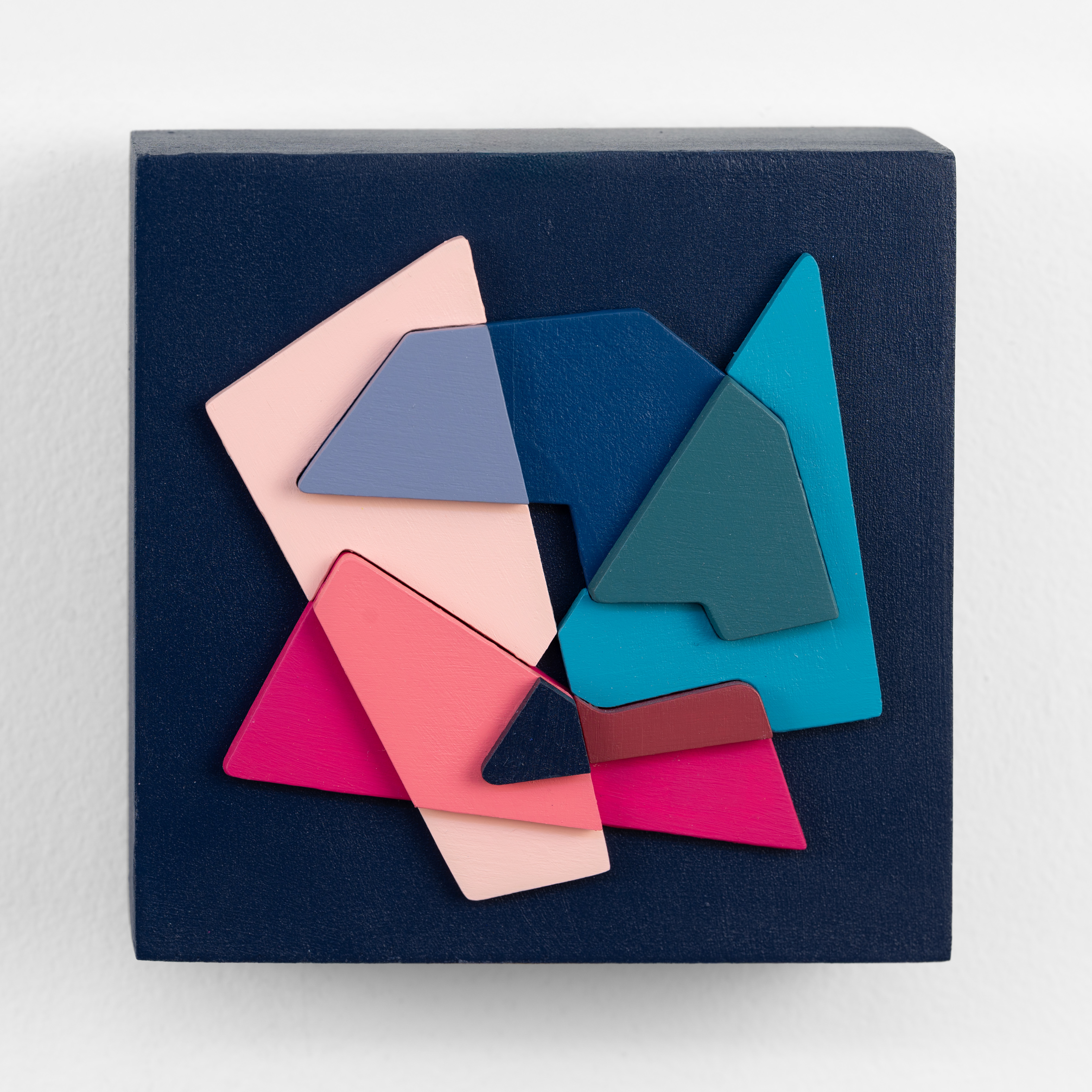
Rhythm Mini #2, acrylic-painted, laser-cut wooden shapes on panel, 5" x 5"
Katie Aronat of Arrowknot Studio creates vibrant abstract art that pops off the panel, using a unique wooden cut-out style to produce depth and dimension. Now based in Chattanooga, TN, her creative journey began with a degree in Design | Media Arts from UCLA. From there, she worked as a graphic designer, motion designer, and creative project manager, including work with notable clients such as Google
Rachel Bubis is a Nashville-based independent arts writer, regular contributor to The Focus blog, and LocateArts.org Web Manager for Tri-Star Arts.
* images courtesy of the artist

